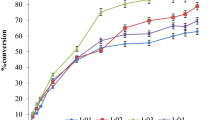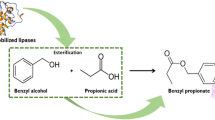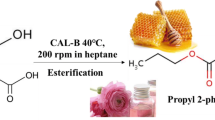Abstract
To overcome the poor properties of solubility and stability of cinnamic acid, cinnamate derivatives with sugar alcohols were produced using the immobilized Candida antarctica lipase with vinyl cinnamate and D-sorbitol as substrate at 45 °C. Immobilized C. antarctica lipase was found to synthesize 6-O-cinnamoyl-sorbitol and confirmed by HPLC and 1H-NMR and had a preference for vinyl cinnamate over other esters such as allyl-, ethyl-, and isobutyl cinnamate as co-substrate with D-sorbitol. Contrary to D-sorbitol, vinyl cinnamate, and cinnamic acid, the final product 6-O-cinnamoyl-sorbitol was found to have radical scavenging activity. This would be the first report on the biosynthesis of 6-O-cinnamoyl-sorbitol with immobilized enzyme from C. antarctica.




Similar content being viewed by others
References
Liu, L., Hudgins, W. R., Shack, S., Yin, M. Q., & Samid, D. (1995). Cinnamic acid: a natural product with potential use in cancer intervention. International Journal of Cancer, 62, 345–350.
Humphreys, J. M., & Chapple, C. (2002). Rewriting the lignin roadmap. Current Opinion in Plant Biology, 5, 224–229.
Boudet, A. M., Kajita, S., Grima-Pettenati, J., & Goffner, D. (2003). Lignins and lignocellulosics: a better control of synthesis for new and improved uses. Trends in Plant Science, 8, 576–581.
Mi, J., Sun, Z. H., Zhong, M. H., Yang, Y. H., Chen, T., Xiong, G. J., Luo, H., & Qi, X. Q. (2012). Predictive factors of chronic thromboembolic pulmonary hypertension in patients with acute pulmonary thromboembolism. Zhonghua Xin Xue Guan Bing Za Zhi, 40, 497–501.
Lone, R., Shuab, R., & Koul, K. K. (2014). Role of cinnamate and cinnamate derivatives in pharmacology. Global Journal of Pharmacology., 8, 328–335.
Yang, Y. H., Raku, T., Song, E., Park, S. H., Yoo, D., Park, H. Y., Kim, B. G., Kim, H. J., Lee, S. H., Kim, H. S., & Tokiwa, Y. (2012). Lipase catalyzed reaction of L-ascorbic acid with cinnamic acid esters and substituted cinnamic acids. Biotechnology and Bioprocess Engineering, 17, 50–54.
Pandey, K. B., & Rizvi, S. I. (2009). Plant polyphenols as dietary antioxidants in human health and disease. Oxidative Medicine and Cellular Longevity, 2, 270–278.
Bradley, J.-C., Neylon, C., Williams, A., Guha, R., Hooker, B., Lang, A. S., Freisen, B., Bohinski, T., Bulger, D., & Federici, M. (2009). Open notebook science challenge: Solubilities of organic compounds in organic solvents. ed. ONS Books.
East, A., Jaffe, M., & Zhang, Y. (2006). Ultraviolet absorber for cosmetics and polymeric materials. Google Patents.
Graf, E. (1992). Antioxidant potential of ferulic acid. Free Radical Biology and Medicine, 13, 435–448.
Leinen, H.-T., Gregori, D., Pujol, M., & Carbó, M. R. (2003). Water, silica polishing agent and humectant comprised of sorbitol, glycerol and polyethylene glycol; transparent; remains in gel form on toothbrush. Google Patents.
Degn, P., & Zimmermann, W. (2001). Optimization of carbohydrate fatty acid ester synthesis in organic media by a lipase from Candida antarctica. Biotechnology and Bioengineering, 74, 483–491.
Raku, T., & Tokiwa, Y. (2003). Chemoenzymatic synthesis of fucose- or rhamnose-branched polymer. Macromolecular Bioscience, 3, 151–156.
Sabally, K., Karboune, S., St-Louis, R., & Kermasha, S. (2006). Lipase-catalyzed transesterification of trilinolein or trilinolenin with selected phenolic acids. Journal of the American Oil Chemists Society, 83, 101–107.
Xu, B., & Chang, S. (2007). A comparative study on phenolic profiles and antioxidant activities of legumes as affected by extraction solvents. Journal of Food Science, 72, S159–S166.
Choi, J., Oh, J., Hwang, I., Kim, S., Jeon, J., Lee, B., Kim, J., Kim, T., & Cho, K. (2003). Application and high throughput screening of DPPH free radical scavenging activity by using 96-well plate. The Korean Journal of Pesticide Science, 7, 92–99.
Sanna, D., Delogu, G., Mulas, M., Schirra, M., & Fadda, A. (2011). Determination of free radical scavenging activity of plant extracts through DPPH assay: an EPR and UV–Vis study. Food Analytical Methods, 5, 759–766.
Artamonov, A., Burkovskaya, L., Nigmatullina, F., & Dzhiembaev, B. Z. (1997). Synthesis of monoesters of D-sorbitol and aromatic acids. Chemistry of Natural Compounds, 33, 571–573.
Jakovetic, S. M., Jugovic, B. Z., Gvozdenovic, M. M., Bezbradica, D. I., Antov, M. G., Mijin, D. Z., & Knezevic-Jugovic, Z. D. (2013). Synthesis of aliphatic esters of cinnamic acid as potential lipophilic antioxidants catalyzed by lipase B from Candida antarctica. Applied Biochemistry and Biotechnology, 170, 1560–1573.
Song, Q. X., & Wei, D. Z. (2002). Study of Vitamin C ester synthesis by immobilized lipase from Candida sp. Journal of Molecular Catalysis B-Enzymatic, 18, 261–266.
Poojari, Y., Beemat, J. S., & Clarson, S. J. (2013). Enzymatic synthesis of poly(epsilon-caprolactone): thermal properties, recovery, and reuse of lipase B from Candida antarctica immobilized on macroporous acrylic resin particles. Polymer Bulletin, 70, 1543–1552.
Arcos, J. A., Bernabe, M., & Otero, C. (1998). Quantitative enzymatic production of 6-O-acylglucose esters. Biotechnology and Bioengineering, 57, 505–509.
Tarahomjoo, S., & Alemzadeh, I. (2003). Surfactant production by an enzymatic method. Enzyme and Microbial Technology, 33, 33–37.
Arcos, J., Bernabe, M., & Otero, C. (1998). Quantitative enzymatic production of 1, 6-diacyl fructofuranoses. Enzyme and Microbial Technology, 22, 27–35.
Degn, P., & Zimmermann, W. (2001). Optimization of carbohydrate fatty acid ester synthesis in organic media by a lipase from Candida antarctica. Biotechnology and Bioengineering, 74, 483–491.
Otto, R. T., Bornscheuer, U. T., Scheib, H., Pleiss, J., Syldatk, C., & Schmid, R. D. (1998). Lipase-catalyzed esterification of unusual substrates: synthesis of glucuronic acid and ascorbic acid (vitamin C) esters. Biotechnology Letters, 20, 1091–1094.
Letizia, C., Cocchiara, J., Lapczynski, A., Lalko, J., & Api, A. (2005). Fragrance material review on cinnamic acid. Food and Chemical Toxicology, 43, 925–943.
Choo, W. S., & Birch, E. (2009). Radical scavenging activity of lipophilized products from lipase-catalyzed transesterification of triolein with cinnamic and ferulic acids. Lipids, 44, 145–152.
Acknowledgments
The authors follow the Instructions for Authors to make sure their manuscript complies to the ethical rules applicable for this journal. The study was partially supported by Basic Science Research Program through the National Research Foundation of Korea (NRF) funded by the Ministry of Education (NRF-2013R1A1A2A10004690), by KOPRI (PE14030), and by the R& D Program of MOTIE/KEIT (10048350) and “Cooperative Research Program for Agriculture Science & Technology Development (Project title: Isolation and identification of rhizobacteria for indoor VOCs removal, Project No. 010205022014)” Rural Development Administration, Republic of Korea. In addition, this research was supported by the 2014 KU Brain Pool of Konkuk University.
Author information
Authors and Affiliations
Corresponding author
Additional information
Jung-Ho Kim and Shashi Kant Bhatia contributed equally to this work.
Electronic Supplementary Material
Below is the link to the electronic supplementary material.
Fig. S1
HPLC chromatogram of each compound with their retention time, i.e., RT = 3.4 for 6-O-cinnamoyl-sorbitol, 4.3 for cinnamic acid, and 64.6 min for vinyl cinnamate (DOC 76 kb).
Rights and permissions
About this article
Cite this article
Kim, JH., Bhatia, S.K., Yoo, D. et al. Lipase-Catalyzed Production of 6-O-cinnamoyl-sorbitol from D-sorbitol and Cinnamic Acid Esters. Appl Biochem Biotechnol 176, 244–252 (2015). https://doi.org/10.1007/s12010-015-1570-x
Received:
Accepted:
Published:
Issue Date:
DOI: https://doi.org/10.1007/s12010-015-1570-x




